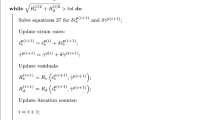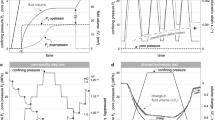Abstract
During geothermal operations, injection and production of fluid can induce significant pore pressure and temperature changes which impact the stress field thus affecting the reservoir performance. In this context, the transport and mechanical properties of the porous rock can be altered by deformation of the pore and bulk volumes. Different poroelastic formulations for describing the hydro-mechanical behavior of porous rocks are considered. Additionally, a formulation for the drained bulk modulus is introduced which takes into account the poroelastic behavior. This poroelastic formulation has been implemented in the 3D finite element method-based simulator OpenGeoSys to predict porosity changes. Based on the porosity changes, permeability variation under different loading conditions as main property controlling transport of mass and energy in porous media is determined by the Kozeny–Carman relation. Triaxial laboratory experiments conducted on two different kinds of sandstones (Flechtinger and Bentheimer) are used to constrain parameters which control porosity changes and thus permeability changes under drained conditions and to calibrate the numerical simulations. Hydrostatic loading from 1 to 70 MPa in confining stress has been simulated for Flechtinger and Bentheimer sandstones resulting in porosity and permeability decreases. Results are compared to experimental measurements to evaluate the precision of each poroelastic model. Reduction in porosity of 8.1 % with about 1.15 % error for the Flechtinger sandstone has been simulated and of 1.4 % with about 0.54 % error for the Bentheimer sandstone.







Similar content being viewed by others
Abbreviations
- \(\alpha \) :
-
Biot’s coefficient (dimensionless)
- \(\epsilon \) :
-
Strain (dimensionless)
- \(\nu \) :
-
Poisson’s ratio (dimensionless)
- \(\sigma \) :
-
Stress (Pa)
- \(\tau \) :
-
Tortuosity (dimensionless)
- \(\phi \) :
-
Porosity (dimensionless)
- a :
-
Aspect ratio (dimensionless)
- E :
-
Young’s modulus (Pa)
- h :
-
Aspect ration quantity (dimensionless)
- k :
-
Permeability (\(\hbox {m}^{2}\))
- K :
-
Bulk’s modulus (Pa)
- p :
-
Pressure (Pa)
- S :
-
Specific surface area (\(\hbox {m}^{-1}\))
- V :
-
Volume (\(\hbox {m}^{3}\))
- \(\phi \) :
-
Pore
- b, p, s :
-
Bulk, pore, solid
- c, e :
-
Confining, effective
- f :
-
Fluid
- d :
-
Drained
- v :
-
Volumetric
- n :
-
Normalized
- \(\infty \) :
-
Final, at high stress
- i :
-
Initial
- u :
-
Unjacketed
References
Bear, J.: Dynamics of Fluids in Porous Media, Dover book edition. Dover, London (1988)
Bernabe, Y.: The effective pressure law for permeability in Chelmsford granite and Barre granite. Int. J. Rock Mech. Min. Sci. 23, 267–275 (1986). doi:10.1016/0148-9062(86)90972-1
Biot, M.A.: General solutions of the equations of elasticity and consolidation for a porous material. J. Appl. Mech. 78, 91–96 (1956)
Biot, M.A.: Nonlinear and semilinear rheology of porous solids. J. Geophys. Res. 78(23), 4924–4937 (1973). doi:10.1029/JB078i023p04924
Blöcher, G., Zimmermann, G., Moeck, I., Brandt, W., Hassanzadegan, A., Magri, F.: 3D numerical modeling of hydrothermal processes during the lifetime of a deep geothermal reservoir. Geofluids 10(3), 406–421 (2010). doi:10.1111/j.1468-8123.2010.00284.x. ISSN:14688115
Blöcher, G., Reinsch, T., Hassanzadegan, A., Milsch, H., Zimmermann, G.: Direct and indirect laboratory measurements of poroelastic properties of two consolidated sandstones. Int. J. Rock Mech. Min. Sci. 67, 191–201 (2013). doi:10.1016/j.ijrmms.2013.08.033. ISSN:13651609
Cacace, M., Blöcher, G., Watanabe, N., Moeck, I., Börsing, N., Scheck-Wenderoth, M., Kolditz, O., Huenges, E.: Modelling of fractured carbonate reservoirs: outline of a novel technique via a case study from the Molasse Basin, southern Bavaria, Germany. Environ. Earth Sci. 70(8), 3585–3602 (2013). doi:10.1007/s12665-013-2402-3. ISSN:1866-6280
Cappa, F., Rutqvist, J.: Modeling of coupled deformation and permeability evolution during fault reactivation induced by deep underground injection of CO2. Int. J. Greenh. Gas Control 5(2), 336–346 (2011). doi:10.1016/j.ijggc.2010.08.005. ISSN:17505836
Carman, P.: Flow of gases through porous media. Butterworths Scientific Publications, London (1956)
Carrol, M.M., Katsube, N.N.: The role of Terzaghi effective stress in linearly elastic deformation. J. Energy Ressour. Technol. 105(4), 509–511 (1983). doi:10.1115/1.3230964
Cherubini, Y., Cacace, M., Blöcher, G., Scheck-Wenderoth, M.: Impact of single inclined faults on the fluid flow and heat transport: results from 3-D finite element simulations. Environ. Earth Sci. 70(8), 3603–3618 (2013). doi:10.1007/s12665-012-2212-z. ISSN:1866-6280
Chin, L.Y., Raghavan, R., Thomas, L.K.: Fully coupled geomechanics and fluid-flow analysis of wells with stress-dependent permeability. Soc. Pet. Eng. 5, 2–6 (2000). doi:10.2118/88870-PA
Dautriat, J., Gland, N., Guelard, J., Dimanov, A., Raphanel, J.L.: Axial and radial permeability evolutions of compressed sandstones: end effects and shear-band induced permeability anisotropy. Pure Appl. Geophys. 166(5–7), 1037–1061 (2009). doi:10.1007/s00024-009-0495-0. ISSN:0033-4553
David, C., Wong, T.-F., Zhu, W., Zhang, J.: Laboratory measurement of compaction-induced permeability change in porous rocks: Implications for the generation and maintenance of pore pressure excess in the crust. Pure Appl. Geophys. PAGEOPH 143(1–3), 425–456 (1994). doi:10.1007/BF00874337. ISSN:0033-4553
Fatt, M.A., Davis, D.H.: Reduction in permeability with overburden pressure. Technical report, California Research Corporation, La Habra (1952)
Faulkner, D.R., Jackson, CaL, Lunn, R.J., Schlische, R.W., Shipton, Z.K., Wibberley, CaJ, Withjack, M.O.: A review of recent developments concerning the structure, mechanics and fluid flow properties of fault zones. J. Struct. Geol. 32(11), 1557–1575 (2010). doi:10.1016/j.jsg.2010.06.009. ISSN:01918141
Ghabezloo, S., Sulem, J., Saint-Marc, J.: Evaluation of a permeability–porosity relationship in a low-permeability creeping material using a single transient test. Int. J. Rock Mech. Min. Sci. 46(4), 761–768 (2009). doi:10.1016/j.ijrmms.2008.10.003. ISSN:13651609
Han, G., Dusseault, M.B.: Description of fluid flow around a wellbore with stress-dependent porosity and permeability. J. Pet. Sci. Eng. 40(1–2), 1–16 (2003). doi:10.1016/S0920-4105(03)00047-0. ISSN:09204105
Hassanzadegan, A., Zimmermann, G.: A poroelastic description of permeability evolution. Pure Appl. Geophys. (2013). doi:10.1007/s00024-013-0714-6. ISSN:0033-4553
Hassanzadegan, A., Blöcher, G., Zimmermann, G., Milsch, H.: Thermoporoelastic properties of Flechtinger sandstone. Int. J. Rock Mech. Min. Sci. 49, 94–104 (2012). doi:10.1016/j.ijrmms.2011.11.002. ISSN:13651609
James, O.: Fluid Mechanics for Chemical Engineering. Wilkes Prentice Hall, Mew Jersey (1999)
Kolditz, O., Bauer, S., Bilke, L., Böttcher, N., Delfs, J.O., Fischer, T., Görke, U.J., Kalbacher, T., Kosakowski, G., McDermott, C.I., Park, C.H., Radu, F., Rink, K., Shao, H., Shao, H.B., Sun, F., Sun, Y.Y., Singh, aK, Taron, J., Walther, M., Wang, W., Watanabe, N., Wu, Y., Xie, M., Xu, W., Zehner, B.: OpenGeoSys: an open-source initiative for numerical simulation of thermo-hydro-mechanical/chemical (THM/C) processes in porous media. Environ. Earth Sci. 67(2), 589–599 (2012a). doi:10.1007/s12665-012-1546-x. ISSN:1866-6280
Kolditz, O., Shao, H., Görke, U.J., Wang, W.: Thermo-Hydro-Mechanical-Chemical Processes in Fractured Porous Media. Lecture Notes in Computational Science and Engineering. Springer, Berlin (2012b). doi:10.1007/978-3-642-27177-9_1
Milsch, H., Blöcher, G., Engelmann, S.: The relationship between hydraulic and electrical transport properties in sandstones: an experimental evaluation of several scaling models. Earth Planet. Sci. Lett. 275(3–4), 355–363 (2008). doi:10.1016/j.epsl.2008.08.031. ISSN:0012821X
Morlier, P.: Description de l’état de fissuration d’une roche à partir d’essais non-destructifs simples. Rock Mech. 138, 125–138 (1971). doi:10.1007/BF01238439
Nishida, A.: Experience in developing an open source scalable software infrastructure in Japan. In: Taniar, D., Gervasi, O., Murgante, B., Pardede, E., Apduhan, B.O. (eds.) Computational Science and Its Applications ICCSA 2010, volume 6017 of Lecture Notes in Computer Science, pp. 448–462. Springer, Berlin (2010). doi:10.1007/978-3-642-12165-4_36
O’Sullivan, M.J., Pruess, K., Lippmann, M.J.: State of the art of geothermal reservoir simulation. Geothermics 30(4), 395–429 (2001). doi:10.1016/S0375-6505(01)00005-0. ISSN:03756505
Raghavan, R., Chin, L.Y.: Productivity changes in reservoirs with stress-dependent permeability. Soc. Pet. Eng. (2004). doi:10.2118/88870-PA
Sisavath, S., Jing, X.D., Zimmerman, R.W.: Effect of stress on the hydraulic conductivity of rock pores. Phys. Chem. Earth Part A 25(2), 163–168 (2000). doi:10.1016/S1464-1895(00)00026-0. ISSN:14641895
Soltanzadeh, H., Hawkes, C.D., Smith, S.A.: Poroelastic modelling of production and injection-induced stress changes in a pinnacle reef. In: Proceedings of the RockEng09: rock engineering in difficult condition, vol. 2009, pp. 1–12 (2009)
Terzaghi, K.: Theoretical Soil Mechanics. Wiley, New York (1943)
Turner, A.K.: Challenges and trends for geological modelling and visualisation. Bull. Eng. Geol. Environ. 65(2), 109–127 (2005). doi:10.1007/s10064-005-0015-0. ISSN:1435-9529
Walder, J., Nur, A.: Porosity reduction and crustal pore pressure development. J. Geophys. Res. Solid Earth (1984). doi:10.1029/JB089iB13p11539
Zimmerman, R.W.: Compressibility of Sandstones. Elsevier, Amsterdam (1991)
Zimmerman, R.W.: Coupling in poroelasticity and thermoelasticity. Int. J. Rock Mech. Min. Sci. 37(1–2), 79–87 (2000). doi:10.1016/S1365-1609(99)00094-5. ISSN:13651609
Acknowledgments
The authors would like to greatly thank Prof. Dr. Olaf Kolditz and his team working on the OpenGeoSys project at the Helmholtz Center for Environmental Research (UFZ) in the Environmental Informatics division for providing helpful support and guidance for using and developing the software OpenGeoSys which has been used during this study. A special acknowledgment to Prof. Dr. Ernst Huenges and the laboratory staff at the GFZ center for providing experimental data conducted on the laboratory equipments under his responsibility. This work was funded by the Helmholtz Association as part of the Helmholtz Portfolio Geo-Energy project.
Author information
Authors and Affiliations
Corresponding author
Appendices
Appendix 1: Governing Equations for Isotropic Elasticity in the OpenGeoSys Software
This “Appendix” presents the initial governing equations for mechanical processes which have been considered in this work. Deformation of the porous medium is described by the momentum balance equation in terms of effective stress as:
where \(\varvec{\sigma }_\mathbf{e}\) is the effective stress tensor and \(\rho _{s}\) is the solid density. The primary variable to be solved is the displacement vector \(\varvec{u}\) by substituting the constitutive law for stress–strain behavior as follow:
with \(\mathbb {C}\) is the forth order material tensor and \(\varvec{\epsilon }\) the strain. The subscript T means the transpose of the matrix. In this work, only isotropic elasticity is considered. Before the implementation described in this work, linear elasticity is described by the generalized Hooke’s law:
where \(\delta \) is the Kronecker delta, \(\mu \) the shear modulus and \(\lambda \) the Lamé constant defined as \(\lambda = \frac{2\mu \nu }{(1-2\nu )}\) with \(\nu \) the Poisson’s ratio. Equation 27 can also be expressed in terms of elastic strain with the Hookes’s linear elastic laws (Eqs. 28–30):
with
-
\(\epsilon _{i}\) strains
-
\(\sigma _{e,i}\) effective stresses
-
E Youngs’s modulus
-
\(\nu \) Poisson’s ratio
OpenGeoSys is based on an object-oriented finite element method concept. In this work, the equations system is solved on quadratic tetrahedral elements. A robust library named LIS (a Library of Iterative Solvers for linear systems, http://ssisc.org/)(Nishida 2010) has been used for the preconditioner and the linear solver.
Appendix 2: Specific Surface Area for a Packed Bed of Spheres
This “Appendix” presents the determination of the specific surface area coefficient used in the permeability determination. These equations are inspired from flow through packed fixed and fluidized beds model for chemical engineering (James 1999). The grains of the sandstone are considered spherical and have all the same radius. Void between these spheres are considered to be all connected (tortuosity \(\tau =1\)). The specific surface area S is defined as:
where \(S_{w}\) is the wetted surface of the grains and \(V_{b}\) the bulk volume. The wetted surface of the grains is equal to the total solid surface area. If there is N grains in a volume V:
The bulk volume \(V_{b}\) is linked to the pore volume by: \(V_{\phi }=\phi V_{b}=\phi \left( V_{\phi }+V_{s}\right) \) which gives:
where \(V_{s}\) is the total volume of grains, \(V_{s}=N\frac{4}{3}\pi r_{g}^{3}\). Substituting Eqs. 32 and 33 in Eq. 31, gives:
which is simplified to:
Rights and permissions
About this article
Cite this article
Jacquey, A.B., Cacace, M., Blöcher, G. et al. Hydro-Mechanical Evolution of Transport Properties in Porous Media: Constraints for Numerical Simulations. Transp Porous Med 110, 409–428 (2015). https://doi.org/10.1007/s11242-015-0564-z
Received:
Accepted:
Published:
Issue Date:
DOI: https://doi.org/10.1007/s11242-015-0564-z




